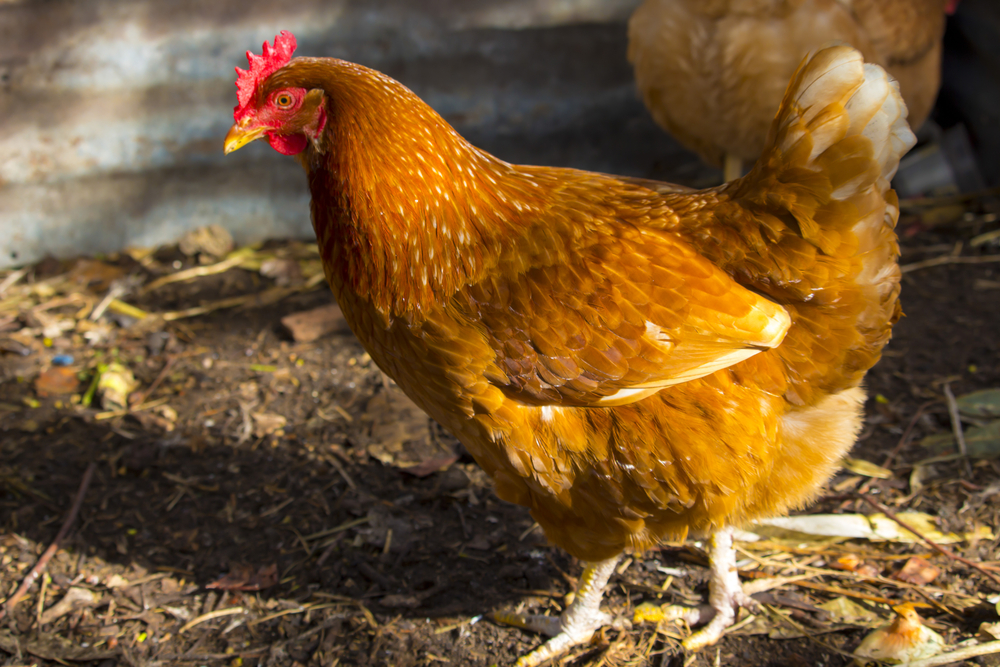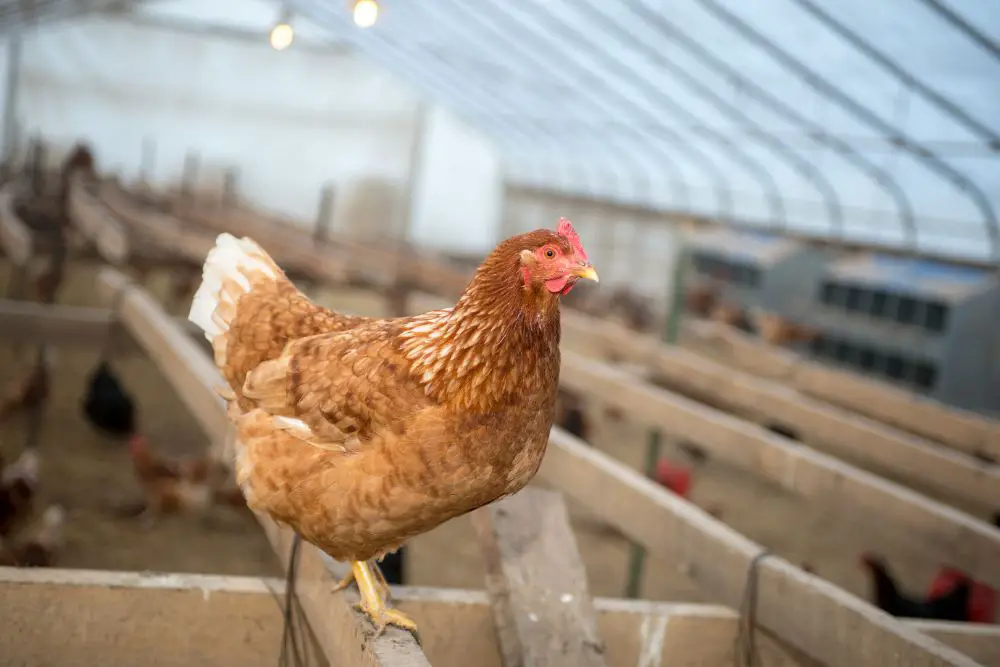Sex link chickens are chickens that you can easily sort by sex and color markings when they are only a few days old. If you're looking to produce a lot of eggs quickly, purchasing sex link chicks allows you to buy only females which saves a ton of time and energy.
This article discusses the most popular breeds and things you should consider before buying sex link chicks.
Table of Contents
What Are Sex Link Chickens?
Sex link chickens are those that began by crossing at least two different types of chickens to create a hybrid chicken with a sex link trait – that is, a recessive coloring trait that will create offspring with a different appearance based on gender.
There are chickens (such as Barred Plymouth Rock) that have autosexing of chicks as well, meaning they are naturally dimorphic. These breeds are not hybrids, but their offspring are naturally two different colors.
For the purpose of this article, the focus will remain on hybrid chickens and sex link traits.
History Of Sex Link Chickens
The history of the sex link chicken begins in the late 1800s and early 1900s at a time when poultrymen were experimenting with crossing two types of purebred chickens with one another. These crosses sometimes produced interesting results, such as chickens with more meat, or higher egg production.
Public opinion on these crosses (which they called mongrels), was not good because most farmers wanted chickens that would breed true generation after generation. However, these crossed chicken breeds were such excellent egg producers, that poultrymen didn’t want to give up on them.
A bit of clever marketing and they were soon selling “hybrid” chickens. The word hybrid had no negative association as it was used with plants at the time and the public began to show interest in hybrid poultry.
While hybrid chicks when bred together produced offspring that couldn’t be counted on to have the same coloring or characteristics, they themselves were valuable in the amount of meat they provided, and the plentiful eggs they produced.
Another thing the poultrymen noticed with certain hybrids was that the male chicks and female chicks consistently had coloring that differed from one another. Thus, the sexlink chicks were created.
Popular Sex Link Chicken Breeds
1. Black Sex Link Chickens
Black sex link chickens may also be called Red Stars, Black Stars, or Rock Reds by breeders.
Black sexlinks are created by crossbreeding a barred rock hen such as a Barred Plymouth Rock hen and a non-barred rooster such as a Rhode Island Red rooster.

This results in female chicks being solid black, and male chicks having a white spot on their heads.
Black sexlink hens are excellent egg layers and will put forth 250 to 280 eggs annually. They aren’t great mothers though and rarely go broody.
2. Red Sex Link Chickens
Red sex link chickens may also be called ISA Browns, Cinnamon Queens, Red Stars, and Golden Comets amongst many other names.
Red sexlinks are a result of crossbreeding a Rhode Island Red rooster or New Hampshire Red Rooster with a Silver Laced Wyandotte, Rhode Island White, White Plymouth Rock, or Delaware hen.

Red sex link chickens can be told apart because male chicks are white or yellow, and female chicks are red or brown with reddish tones.
Red sex link hens tend to be healthy, active, and good egg layers providing between 215 to 275 eggs per year with some varieties such as Cinnamon Queens putting forth 300 eggs per year!
3. Sapphire Gems
Known as a “Blue” or sometimes called a “Gray” chicken breed, Sapphire Gems actually are neither. They do have recessive blue or lavender genes for color, and as adults have a blue/gray appearance.

They are sex link hybrid chickens because male chicks will have a white spot on their forehead, and female chicks won’t.
They are one of the best brown egg layers out there, laying nearly 300 brown eggs per year and are known for hardiness and adaptability.
Considerations For Owners
Whether you select for utility, looks, temperament, size, health, or adaptability, there are a lot of things to consider when choosing the right breed for your backyard flock.
Purpose
There are many things to consider when choosing baby chicks. Whether you are looking for a dual-purpose backyard chicken, or simply want an egg-laying or meat production breed, understanding what you will use them for will considerably narrow your list of options.
If you want a strong egg-laying breed, you should look for red sexlink hens, particularly Cinnamon Queens or ISA Browns which can reliably produce hundreds of eggs each year.
If you’re interested in a meat production chicken, you may look for black sexlink cockerels who will grow to 8 or 9 pounds at maturity.
Temperament Considerations
The next thing to consider is the temperament of the ideal chicken for you. Do you want chickens who are docile and easy to handle, or do you want to keep them at arm’s length as utility or meat birds only?
If you’re planning on having these birds as pets, be aware that sex link chickens don’t have the longevity of pure breeds and rarely live more than 6 years.
Space Considerations
Another consideration is how much space you have for both the chicken coop and chicken run area. Will the chickens be free-range or mostly be kept in confinement?
Some chicken breeds need a lot of space to roam and forage, while others are perfectly content to be couch potatoes and wait for you to fill their feed bucket every morning.
Breeding Considerations
A consideration if you are planning on breeding baby chicks is whether the hens are naturally broody. Will you need an incubator in the hatchery and are you prepared to egg-sit?
Also, are you willing to wait around for these baby chicks to grow into adult chickens (which can take 5-8 months) before they are useful?
If the answer is yes, and you want to breed sex link chicks, you certainly can!
Understanding the genetics behind each crossbreeding attempt will be important so you get the end result you desire as hybrid chickens cannot breed true in successive generations.
Also, some sex link chickens do not like to be in mixed flocks and you may have a harder time breeding them.
Climate Considerations
Some chickens are adaptable and great in warm or cold environments, but others are not and if you choose a chicken breed that is not able to acclimate to your climate, you will likely not get the results you desire.
Unhappy chickens do not lay eggs or put on weight. Birds that are not cold hardy can die in cold climates or have frostbite on their comb, while birds not suited for heat can become sick if they can’t cool off.
FAQs
Where can you purchase sex link chickens?
Sex link chickens are widely available, but it’s best to choose a reputable breeder. Cackle Hatchery offers sex link chickens at affordable prices and are highly regarded in the industry.
What is a Disadvantage to Having Sexlink Chickens?
Chicken keepers who want chickens that breed true should not get sexlink chickens. Additionally, sexlink chickens do not have long lives and rarely live past 6 years.
What color are the eggs of Sexlink Chickens?
Sexlink chickens usually produce eggs that are a shade of brown. They also are usually a large size.
How Many Eggs do Sexlink Chickens Lay?
As prolific egg layers, most sexlink hens will lay between 215 and 320 eggs per year.

